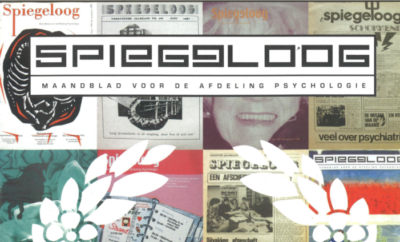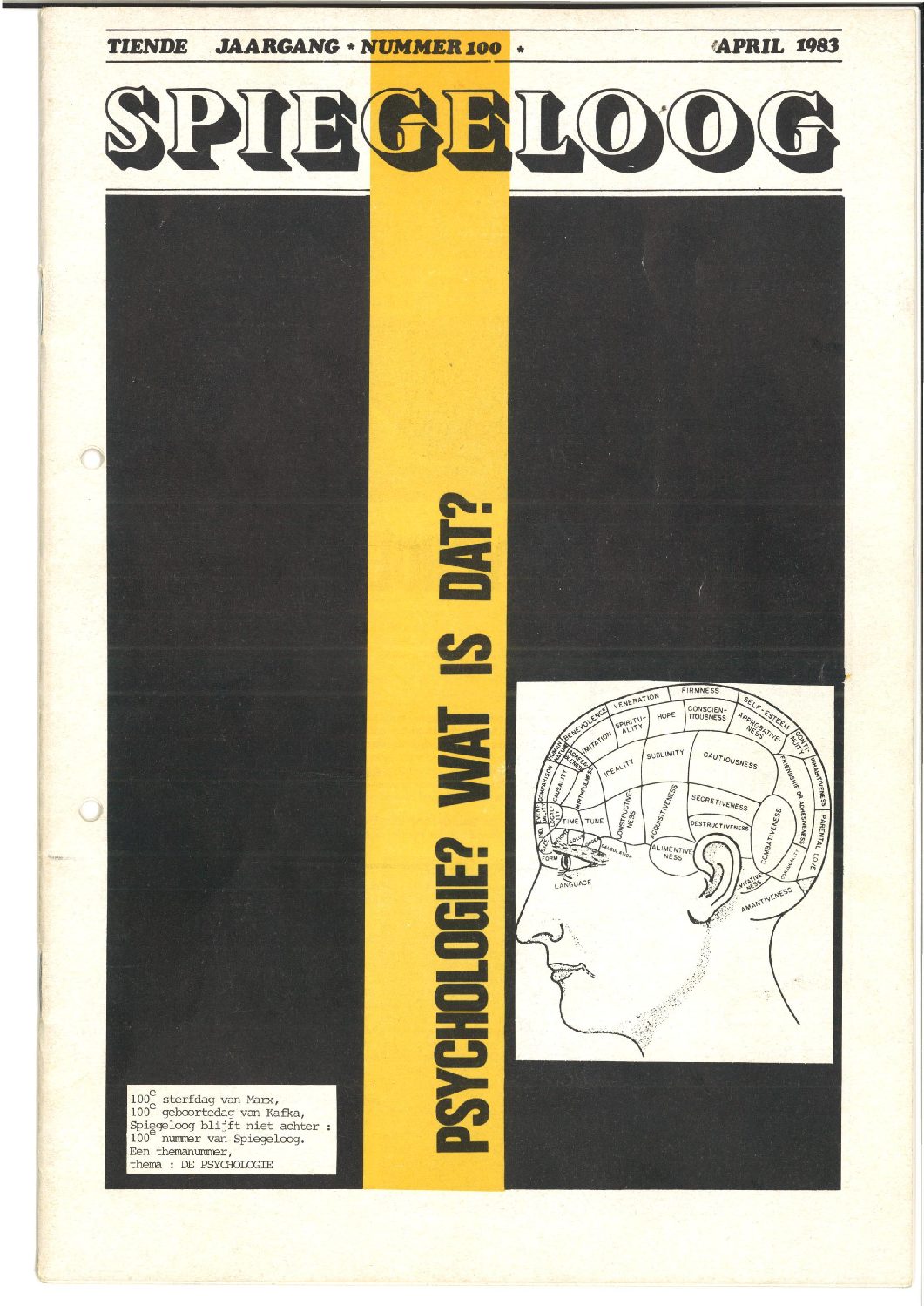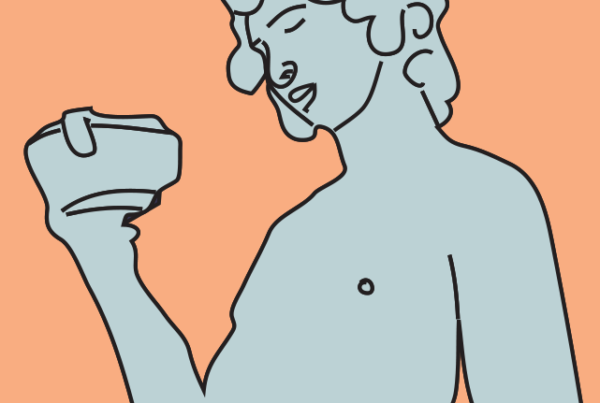
Leave the past behind and look forward. According to social media, that is what we would most like to do. But once in a while, when an anniversary lurks in that near future, we take a moment to breathe outside of our fast paced lives, to take a look from afar and, in the best cases, admire the road we left behind.
Leave the past behind and look forward. According to social media, that is what we would most like to do. But once in a while, when an anniversary lurks in that near future, we take a moment to breathe outside of our fast paced lives, to take a look from afar and, in the best cases, admire the road we left behind.

Cover of Spiegeloog: 100

Cover for Spiegeloog: 100
While many editors come and go, Spiegeloog a mark in their lives, the magazine has already completed a long, turbulent road, a journey of 50 years. A great opportunity for the editors to look back, and also the ideal way to get acquainted with Spiegeloog. After a search through the archives, I managed to pull out the first Spiegeloog, which came out in the spring of 1973. The now yellowed issue with a simplistic layout turned out to be the starting point of a long series of editions full of opinions and news from all corners of the ‘sub-faculty’.
That the magazine would still exist 50 years later did not seem so obvious at the time. Spiegeloog was created by Peter Utrecht, after Mr. Meijer retired. Mr. Meijer was the porter of the psychology lab and in the years before his retirement he kept the students informed of all developments within the department through a biweekly newsletter. Utrecht decided to turn this into a monthly bulletin. He did not have to think long about the name of the magazine; his neighbor, whose father was a psychologist, gave him the idea. The first issue of Spiegeloog materialized in March 1973.
The second issue took longer than planned. Because of lack of money, among other reasons, it did not appear until November. The third issue was published six months later, and from then on Spiegeloog seemed to be doing well. Until, only a year later, it came under fire again due to a report by the ‘Evaluation Commission Subfakulteitsblad’. According to them, Spiegeloog was said to be a “one-sided student magazine, full of insinuating pieces and personal allegations” and a “left-wing activist stronghold” that “set students against the establishment” (Molenaar, 2005). The editors argued that this comment was only because Spiegeloog’s somewhat critical stance would have gone down the wrong path with some faculty members. Spiegeloog therefore decided not to resign itself to this and worked with the VSPA to ensure that it survived this, and all the storms that followed. Thus, in 1983, the magazine endured another threat of closure due to budget cuts and, after Building Management came up with the idea that all student bodies would easily fit into one large room, had to fight in 2004 to maintain their own independent newsroom.
The 50th year anniversary is obviously not the first anniversary issue that has come out of Spiegeloog. Former editorial board members preceded me in previous issues with a look back to the early Spiegeloog days. For example, Joeri van Dalen, the magazine’s first student assistant for the 100th issue, wrote an article looking back to his time at Spiegeloog. In it, he writes that staff members would have preferred Spiegeloog to be a neutral staff magazine or school newspaper, in which nothing but good things would be written about the department and its staff members, but that Spiegeloog was founded precisely for the purpose of “critically monitoring the policies of the sub-faculty and the power games involved” (Van Dalen, 1983). According to Van Dalen, the magazine’s democratic task was to provide students with “information about the ins and outs of the sub-faculty,” and Spiegeloog’s critical note provided a bit of democracy within the department.
Meanwhile, Spiegeloog sings a critical tune and has evolved into a colorful, creative collection of articles, essays, opinion pieces, scholarly contributions and book reviews, among other things, with an open, psychological view of the world inside and outside the faculty. A lot has changed over the years, but two things have remained the same: the recurring threat of fate and Spiegeloog’s ability to master this impending fate each time.
“Fate may threaten, but Spiegeloog stays on top of this every time.”
A few years ago, Spiegeloog again had to contend with budget cuts from the department. At the same time, thought was being given to how the magazine could continue to be made future-proof and sustainable. After 47 years of appearing monthly next to the entrance of the psychology building, it was therefore decided to move Spiegeloog to the virtual world. Two birds with one stone, we call it. Spiegeloog thus simply continues its path, looking to the future: on to the next milestone. <<
References
– Molenaar, J. (2005, oktober). 300 Nummers: een Terugblik. Spiegeloog, p. 4-5.
– Van Dalen, J. (1983, april). Dromen van de Duivel. Spiegeloog, p. 33-35.
While many editors come and go, Spiegeloog a mark in their lives, the magazine has already completed a long, turbulent road, a journey of 50 years. A great opportunity for the editors to look back, and also the ideal way to get acquainted with Spiegeloog. After a search through the archives, I managed to pull out the first Spiegeloog, which came out in the spring of 1973. The now yellowed issue with a simplistic layout turned out to be the starting point of a long series of editions full of opinions and news from all corners of the ‘sub-faculty’.
That the magazine would still exist 50 years later did not seem so obvious at the time. Spiegeloog was created by Peter Utrecht, after Mr. Meijer retired. Mr. Meijer was the porter of the psychology lab and in the years before his retirement he kept the students informed of all developments within the department through a biweekly newsletter. Utrecht decided to turn this into a monthly bulletin. He did not have to think long about the name of the magazine; his neighbor, whose father was a psychologist, gave him the idea. The first issue of Spiegeloog materialized in March 1973.
The second issue took longer than planned. Because of lack of money, among other reasons, it did not appear until November. The third issue was published six months later, and from then on Spiegeloog seemed to be doing well. Until, only a year later, it came under fire again due to a report by the ‘Evaluation Commission Subfakulteitsblad’. According to them, Spiegeloog was said to be a “one-sided student magazine, full of insinuating pieces and personal allegations” and a “left-wing activist stronghold” that “set students against the establishment” (Molenaar, 2005). The editors argued that this comment was only because Spiegeloog’s somewhat critical stance would have gone down the wrong path with some faculty members. Spiegeloog therefore decided not to resign itself to this and worked with the VSPA to ensure that it survived this, and all the storms that followed. Thus, in 1983, the magazine endured another threat of closure due to budget cuts and, after Building Management came up with the idea that all student bodies would easily fit into one large room, had to fight in 2004 to maintain their own independent newsroom.
The 50th year anniversary is obviously not the first anniversary issue that has come out of Spiegeloog. Former editorial board members preceded me in previous issues with a look back to the early Spiegeloog days. For example, Joeri van Dalen, the magazine’s first student assistant for the 100th issue, wrote an article looking back to his time at Spiegeloog. In it, he writes that staff members would have preferred Spiegeloog to be a neutral staff magazine or school newspaper, in which nothing but good things would be written about the department and its staff members, but that Spiegeloog was founded precisely for the purpose of “critically monitoring the policies of the sub-faculty and the power games involved” (Van Dalen, 1983). According to Van Dalen, the magazine’s democratic task was to provide students with “information about the ins and outs of the sub-faculty,” and Spiegeloog’s critical note provided a bit of democracy within the department.
Meanwhile, Spiegeloog sings a critical tune and has evolved into a colorful, creative collection of articles, essays, opinion pieces, scholarly contributions and book reviews, among other things, with an open, psychological view of the world inside and outside the faculty. A lot has changed over the years, but two things have remained the same: the recurring threat of fate and Spiegeloog’s ability to master this impending fate each time.
“Fate may threaten, but Spiegeloog stays on top of this every time.”
A few years ago, Spiegeloog again had to contend with budget cuts from the department. At the same time, thought was being given to how the magazine could continue to be made future-proof and sustainable. After 47 years of appearing monthly next to the entrance of the psychology building, it was therefore decided to move Spiegeloog to the virtual world. Two birds with one stone, we call it. Spiegeloog thus simply continues its path, looking to the future: on to the next milestone. <<



